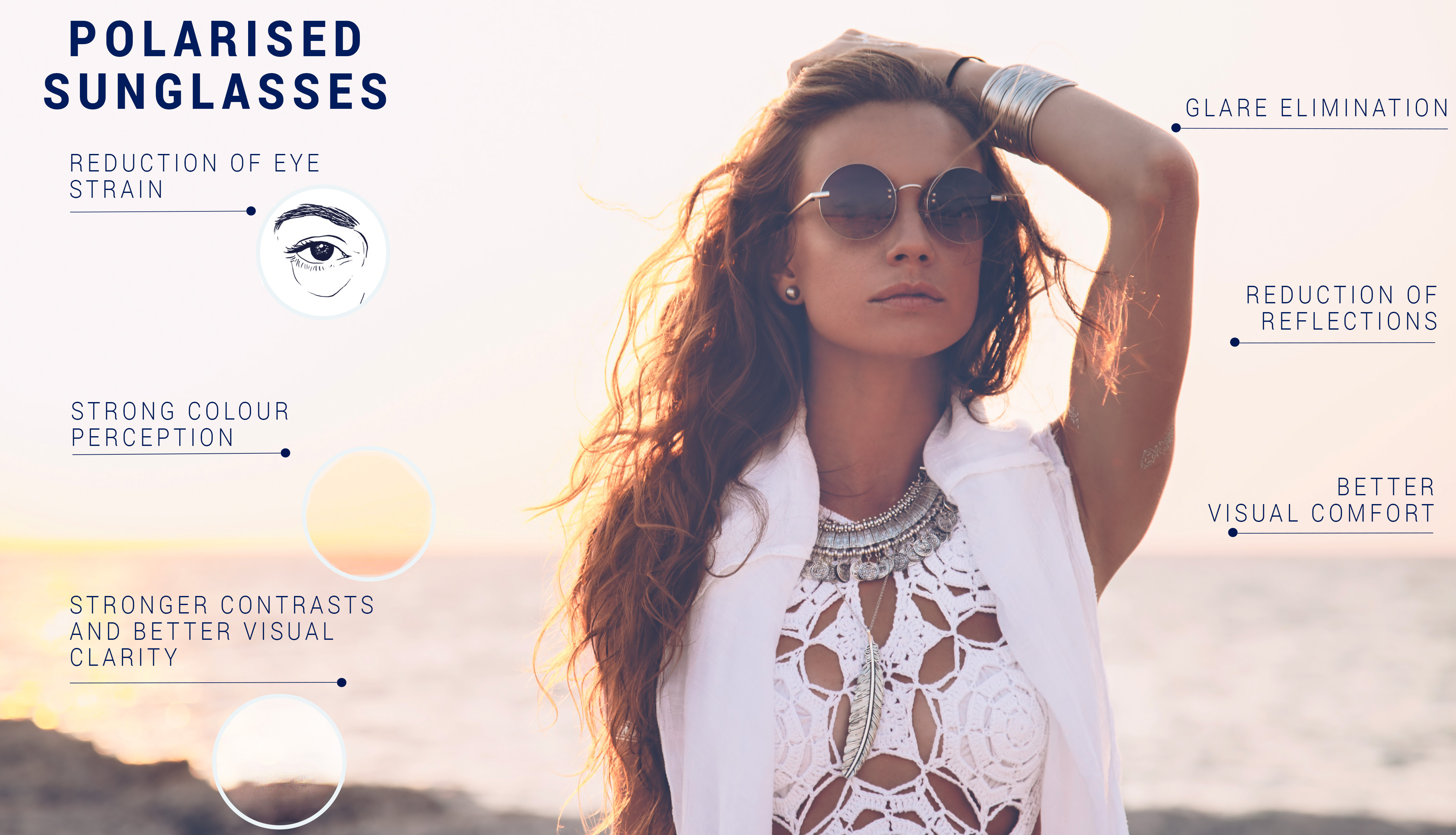Polarised vs. mirrored sunglasses: Which to choose?

Given the choice between polarised or mirrored sunglasses, do you know which ones you'd choose? Understanding the differences between these two types of lenses can help you select ones that work for your needs. (Spoiler alert: although they're different, you don't have to pick one or the other!)
Whether you want to know more about the glare-reducing properties of polarisation or the aesthetic component of mirroring, the experts at Lentiamo have got you covered. Learn about the differences between these two types of sunglasses, see how they work, and read about the advantages of polarisation and mirroring below.
What are polarised sunglasses?
Polarised sunglasses are designed to reduce glare and improve visual clarity. From the outside, they look like any typical pair of sunglasses. The difference lies in the chemical filter that is added to the lenses.
How do polarised lenses work?
Polarised sunglasses filter out horizontal light waves that are reflected off flat surfaces like water, snow, or glass. To achieve this, a special polarisation filter is applied in a vertical orientation. This alters the path of horizontal light, effectively reducing bright and bothersome glare caused by the horizontal waves.
What’s the difference between polarised and non-polarised sunglasses?
The level of glare reduction is one of the main differences between polarised and non-polarised sunglasses. Since they aren't equipped with the special filter, non-polarised sunglasses generally don't offer the same level of clarity or glare reduction.
The filter on polarised lenses can also make it difficult to read LCD screens. This can be an issue when using mobile phones, looking at car displays, or using other screens such as navigation devices.
What are the main advantages of polarised lenses?
The main advantages of polarisation are glare reduction, better contrast and colour perception, and enhanced visual clarity. They can reduce eye strain and provide more comfortable and clearer vision, especially on super sunny days or around reflective surfaces.

They're beneficial during water activities like fishing or boating. For example, some of the best fishing sunglasses feature polarised lenses that cut glare and help you see into the water. You can get a better understanding of some of the advantages of polarised sunglasses in the visual above.
How do I know if my sunglasses are polarised?
You can determine if your sunglasses are polarised in three easy steps:
- Put your sunglasses on – Position your sunglasses as you'd normally wear them.
- Look at a screen – Sit directly in front of a phone or computer screen. Note you may not notice any changes in the screen at this point.
- Tilt your head – Tilt your head 60 degrees to the left and right. If the screen turns black one way or the other, your sunglasses are polarised.

For the best results, use a white screen. The brightness will make the effect of the test more prominent. If your sunglasses are polarised, your view might change and look something like the visual above.
Want to effectively reduce glare and see clearly?
Check out a wide selection of polarised sunglasses today.
What are mirrored sunglasses?
Mirrored sunglasses are treated with a thin, metallic coating. This extra layer reflects light away from the eyes and gives the lenses their distinct mirrored appearance.
How do mirrored lenses work?
Mirrored lenses use both traditional tinting plus a reflective optical layer called a mirror or flash coating. This special coating reflects sunlight, greatly reducing the amount of light that passes through the lenses by 10–60%.
These reflective sunglasses typically use several different coatings. After the metal film is deposited, plastic coatings are added for protection and glare reduction. This is what ultimately results in the shiny, mirror-like finish many people choose solely for style purposes.
What then are the advantages of mirrored sunglasses?
Mirrored lenses offer several advantages including reducing light reflections, improving visual comfort, and providing high UV protection compared to standard lenses.

This makes them particularly advantageous for activities in very bright conditions like skiing on a sunny day, cycling in open areas, or climbing and hiking. You can see some of the advantages of mirrored sunglasses in the visual above.
Are polarised or mirrored lenses better?
While both types of lenses effectively improve vision in bright light, neither are better or worse than the other. Mirrored lenses are often favoured for activities such as cycling, skiing, climbing in open areas. On the other hand, polarised lenses are particularly useful for water activities like fishing and boating due to their ability to selectively filter out horizontal light.
Check out the main benefits of mirrored vs polarised sunglasses at a glance:
Polarised sunglasses
- Effective glare reduction
- Improved visual clarity
- Increased eye comfort
- Minimal colour distortion
Mirrored sunglasses
- High level of light reduction
- High UV protection
- Stylish colours and unique look
- Durable lenses
Can sunglasses be polarised and mirrored?
Yes, sunglasses can be both polarised and mirrored. Mirrored lenses have a highly reflective coating applied to the outside, while polarised sunglasses have a specialised chemical filter that reduces glare. For example, many Polaroid sunglasses offer polarised, mirrored, or combination lenses.
Mirrored polarised sunglasses provide the benefits of reduced glare, improved visual clarity, and reduced light transmission. They also offer the stylish appearance of mirrored lenses.
Polarised or mirrored lenses can be added to many frames, allowing you to keep up with sunglasses trends while staying protected.
Can't decide between mirrored or polarised shades?
Browse the entire sunglasses selection to find your favourites.
Closing thoughts
For sunglasses, considering polarised vs mirrored doesn't have to be a hard decision. The key is to find styles that you love and sunglasses that perform for you! So whether you want to stop glare, reduce light, or a combination of both, there are shades for you.
Still not sure? Let our sunglasses virtual try on feature help you try frames online.
Read more
Style advice and tips for choosing the right sunglasses



